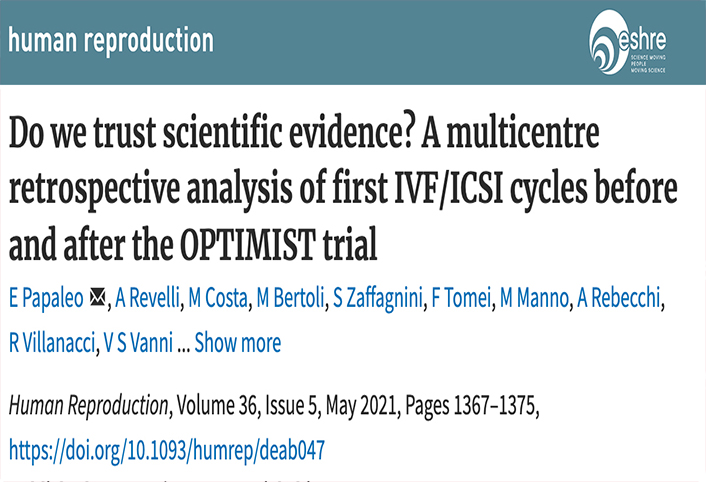
Do we trust scientific evidence? A multicentre retrospective analysis of first IVF/ICSI cycles before and after the OPTIMIST trial
E Papaleo, A Revelli, M Costa, M Bertoli, S Zaffagnini, F Tomei, M Manno, A Rebecchi, R Villanacci, V S Vanni, F Cantatore, A Ruffa D Colia, M Sironi, T Tessari, F Parissone, I Romanello, M Reschini, C Dallagiovanna, E Somigliana
Abstract
Study question: Has the practice of individualizing the recombinant-FSH starting dose been superseded after the largest randomized controlled trial (RCT) in assisted reproduction technology (ART), the OPTIMIST trial?
Summary answer: The OPTIMIST trial has influenced our ART daily practice to a limited degree, but adherence is still generally poor.
What is known already: Although the ‘one size fits all’ approach has been discouraged for decades by most authors, the OPTIMIST study group demonstrated in a large prospective RCT that, in general, dosage individualization does not improve the prospects for live birth, although it may decrease ovarian hyperstimulation syndrome (OHSS) risk in expected high responders.
Study design, size, duration: Retrospective analysis of all first in vitro fertilization (IVF)/intracytoplasmic sperm injection (ICSI) cycles from 1st January 2017 to 31st December 2018, before and after the OPTIMIST publication on November 2017.
Participants/materials, setting, methods: Two thousand six hundred and seventy-seven patients, between 18 and 42 years old, undergoing their first IVF-ICSI cycle in seven Italian fertility centres, were included. Patients were allocated to three groups according to their ovarian reserve markers: predicted poor ovarian responders (POR), predicted normo-responders (NR) and expected hyper-responders (HRs).
Main results and the role of chance: Between 2017 and 2018, there was an overall increase in prescription of the standard 150 IU dose proposed by the OPTIMIST trial and a reduction in the use of a starting dose >300 IU. After subgroup analysis, the decrease in doses >300 IU remained significant in the POR and NR sub-groups.
Limitations, reasons for caution: The retrospective nature of the study. Physicians need time to adapt to new scientific evidence and a comparison between 2017 and 2019 may have found a greater impact of the Optimist trial, although other changes over the longer time span might have increased confounding. We cannot be sure that the observed changes can be attributed to knowledge of the OPTIMIST trial.
Wider implications of the findings: Clinicians may be slow to adopt recommendations based on RCTs; more attention should be given to how these are disseminated and promoted.
Study funding/competing interest(s): No external funding was used for this study. E.P. reports grants and personal fees from MSD, grants from Ferring, from IBSA, grants and personal fees from Merck, grants from TEVA, grants from Gedeon Richter, outside the submitted work. E.S. reports grants from Ferring, grants and personal fees from Merck-Serono, grants and personal fees from Theramex, outside the submitted work. All other authors do not have conflicts of interest to declare.

